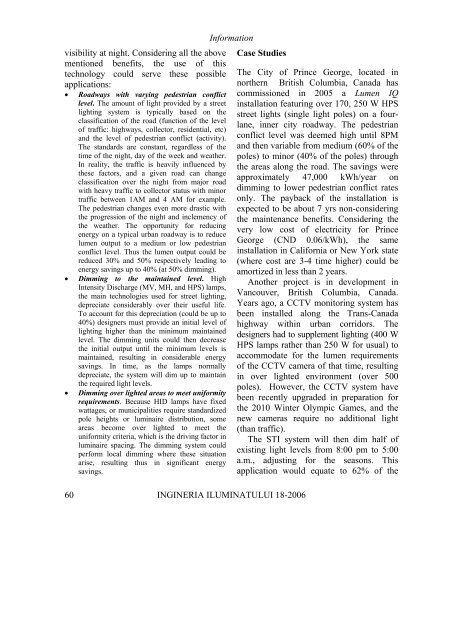This issue is sponsored by the Philips Romania, Lighting Division
This issue is sponsored by the Philips Romania, Lighting Division
This issue is sponsored by the Philips Romania, Lighting Division
Create successful ePaper yourself
Turn your PDF publications into a flip-book with our unique Google optimized e-Paper software.
v<strong>is</strong>ibility at night. Considering all <strong>the</strong> above<br />
mentioned benefits, <strong>the</strong> use of th<strong>is</strong><br />
technology could serve <strong>the</strong>se possible<br />
applications:<br />
• Roadways with varying pedestrian conflict<br />
level. The amount of light provided <strong>by</strong> a street<br />
lighting system <strong>is</strong> typically based on <strong>the</strong><br />
classification of <strong>the</strong> road (function of <strong>the</strong> level<br />
of traffic: highways, collector, residential, etc)<br />
and <strong>the</strong> level of pedestrian conflict (activity).<br />
The standards are constant, regardless of <strong>the</strong><br />
time of <strong>the</strong> night, day of <strong>the</strong> week and wea<strong>the</strong>r.<br />
In reality, <strong>the</strong> traffic <strong>is</strong> heavily influenced <strong>by</strong><br />
<strong>the</strong>se factors, and a given road can change<br />
classification over <strong>the</strong> night from major road<br />
with heavy traffic to collector status with minor<br />
traffic between 1AM and 4 AM for example.<br />
The pedestrian changes even more drastic with<br />
<strong>the</strong> progression of <strong>the</strong> night and inclemency of<br />
<strong>the</strong> wea<strong>the</strong>r. The opportunity for reducing<br />
energy on a typical urban roadway <strong>is</strong> to reduce<br />
lumen output to a medium or low pedestrian<br />
conflict level. Thus <strong>the</strong> lumen output could be<br />
reduced 30% and 50% respectively leading to<br />
energy savings up to 40% (at 50% dimming).<br />
• Dimming to <strong>the</strong> maintained level. High<br />
Intensity D<strong>is</strong>charge (MV, MH, and HPS) lamps,<br />
<strong>the</strong> main technologies used for street lighting,<br />
depreciate considerably over <strong>the</strong>ir useful life.<br />
To account for th<strong>is</strong> depreciation (could be up to<br />
40%) designers must provide an initial level of<br />
lighting higher than <strong>the</strong> minimum maintained<br />
level. The dimming units could <strong>the</strong>n decrease<br />
<strong>the</strong> initial output until <strong>the</strong> minimum levels <strong>is</strong><br />
maintained, resulting in considerable energy<br />
savings. In time, as <strong>the</strong> lamps normally<br />
depreciate, <strong>the</strong> system will dim up to maintain<br />
<strong>the</strong> required light levels.<br />
• Dimming over lighted areas to meet uniformity<br />
requirements. Because HID lamps have fixed<br />
wattages, or municipalities require standardized<br />
pole heights or luminaire d<strong>is</strong>tribution, some<br />
areas become over lighted to meet <strong>the</strong><br />
uniformity criteria, which <strong>is</strong> <strong>the</strong> driving factor in<br />
luminaire spacing. The dimming system could<br />
perform local dimming where <strong>the</strong>se situation<br />
ar<strong>is</strong>e, resulting thus in significant energy<br />
savings.<br />
60<br />
Information<br />
Case Studies<br />
INGINERIA ILUMINATULUI 18-2006<br />
The City of Prince George, located in<br />
nor<strong>the</strong>rn Brit<strong>is</strong>h Columbia, Canada has<br />
comm<strong>is</strong>sioned in 2005 a Lumen IQ<br />
installation featuring over 170, 250 W HPS<br />
street lights (single light poles) on a fourlane,<br />
inner city roadway. The pedestrian<br />
conflict level was deemed high until 8PM<br />
and <strong>the</strong>n variable from medium (60% of <strong>the</strong><br />
poles) to minor (40% of <strong>the</strong> poles) through<br />
<strong>the</strong> areas along <strong>the</strong> road. The savings were<br />
approximately 47,000 kWh/year on<br />
dimming to lower pedestrian conflict rates<br />
only. The payback of <strong>the</strong> installation <strong>is</strong><br />
expected to be about 7 yrs non-considering<br />
<strong>the</strong> maintenance benefits. Considering <strong>the</strong><br />
very low cost of electricity for Prince<br />
George (CND 0.06/kWh), <strong>the</strong> same<br />
installation in California or New York state<br />
(where cost are 3-4 time higher) could be<br />
amortized in less than 2 years.<br />
Ano<strong>the</strong>r project <strong>is</strong> in development in<br />
Vancouver, Brit<strong>is</strong>h Columbia, Canada.<br />
Years ago, a CCTV monitoring system has<br />
been installed along <strong>the</strong> Trans-Canada<br />
highway within urban corridors. The<br />
designers had to supplement lighting (400 W<br />
HPS lamps ra<strong>the</strong>r than 250 W for usual) to<br />
accommodate for <strong>the</strong> lumen requirements<br />
of <strong>the</strong> CCTV camera of that time, resulting<br />
in over lighted environment (over 500<br />
poles). However, <strong>the</strong> CCTV system have<br />
been recently upgraded in preparation for<br />
<strong>the</strong> 2010 Winter Olympic Games, and <strong>the</strong><br />
new cameras require no additional light<br />
(than traffic).<br />
The STI system will <strong>the</strong>n dim half of<br />
ex<strong>is</strong>ting light levels from 8:00 pm to 5:00<br />
a.m., adjusting for <strong>the</strong> seasons. <strong>Th<strong>is</strong></strong><br />
application would equate to 62% of <strong>the</strong>
















